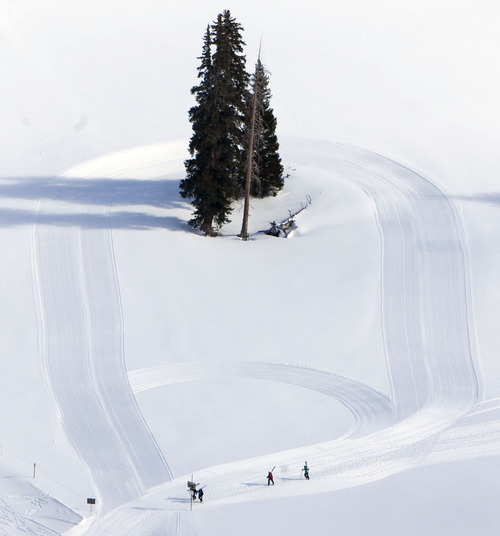This is an archived article that was published on sltrib.com in 2010, and information in the article may be outdated. It is provided only for personal research purposes and may not be reprinted.
Alta • Brie, the avalanche rescue dog, located a snow-bound body, barked three times to alert human searchers, and began digging out the "victim" at the top of Hidden Peak. But the audience of risk experts held their cheers until the yellow Labrador got her reward of a game of tug.
The avalanche rescue drill was the climax of a day of presentations on how avalanche professionals, including Snowbird ski patrol members, reduce the risk of "white death" in the canyons of the Wasatch Mountains. The dozen risk scientists and professionals watching were a small contingent from the annual conference of the Society for Risk Analysis meeting in Salt Lake City.
The workshop, "Living with the White Death," offered in the ski resort town of Alta, was eye-opening to the attendees, who deal with risks ranging from environmental disasters to food-borne disease to terrorism.
The risk of avalanches in Little Cottonwood Canyon is so extensive and frequent that Utah experts acknowledge that a loss of life is always a possibility and freely discuss dire events like the "cosmic tumblers [of catastrophe] clicking into place" and the likelihood of the avalanche equivalent of a "perfect storm."
"Sometimes nature can overcome the best-laid plans," said Jon Nepstad, an avalanche hazard specialist who worked on a 2006 study of Little Cottonwood's State Road 210. "And it happens really quickly."
Because funding for passive protective barriers such as snow sheds or alternate roads are so expensive and environmentally damaging, avalanche fighters in the canyon are forced to fire an average of 530 artillery rounds every year out of military howitzers into the canyon's avalanche chutes. The induced avalanches protect the public from a catastrophic one. Still, two or three avalanches reach the canyon road each year.
Nepstad showed a simulated video of a "perfect storm" avalanche in Little Cottonwood: It's 5 p.m. on the longest night of the year and snow is falling at 2 inches per hour as skiers crowd onto the road to return to the city below. An avalanche slides down one of the 30 active avalanche chutes and blocks the road. That's bad enough, but the resulting queue of vehicles backs traffic up into another of the avalanche zones higher up the canyon.
The cars, trucks and buses, crowded with humanity, are at a dead-stop in the path of a highly probable second avalanche. "Most of the time one avalanche means more will come," Nepstad says.
Little Cottonwood experiences several times as many avalanches as other stretches of road in North America and more than 50 structures have been hit by snow slides. Considering the amount of traffic on SR 210 during ski season, avalanche experts say it is one of "the most dangerous highways in the world."
So far only one person has been killed by an avalanche on the road. (Avalanches, however, kill about four back-country skiers in the canyon each year.)
"We recognize next week, next month this could change," said Liam Fitzgerald, lead avalanche forecaster for the Utah Department of Transportation. "Any building in an avalanche path is on borrowed time. Safety depends on military artillery."
Though that information apparently has next to no dampening effect on skiers, it's the kind of statement that gives risk scientists the chills. It's not lost on them that Our Lady of the Snows Church, in which they attended the workshop, is a replacement for a church that was swept away by a wall of snow in 1983.
Ana Matu, a risk science expert from the Ontario Canada Ministry of Agriculture, Food and Rural Affairs, was taken aback by the presentations.
"The more you know about [avalanche risk], the more you know how little you can do about it." Matu said. "And they don't have funds to do anything about it. It's a nightmare. God forbid there's going to be one of these worst-case scenarios."
Lauren Fleishman, a post-graduate student in risk communication at Pittsburgh's Carnegie-Mellon University, found the workshop fascinating because the people at risk of being caught in an avalanche represent an unusual statistical group.
"Most of the public is risk averse," Fleishman said. "This [skiers, boarders and snow-machine users] is a risk-seeking group."
Seema Schappelle, a science adviser for the U.S. Environmental Protection Agency, was intrigued that avalanche risk is managed in Utah by firing live artillery rounds over inhabited areas. (In 2005, a 105mm howitzer round overshot its intended target in Provo Canyon and exploded in a Pleasant Grove suburb.)
Schappelle, too, noted the challenge avalanche managers face in trying to reach and educate a risk-taking demographic. "Who'd have thought?" she said. "It's definitely a different audience."
Bruce Tremper, director of the U.S. Forest Service's Utah Avalanche Center, says many solutions to avalanche risk have yet to be developed due to lack of funding. "There aren't enough people dying in avalanches to fund the millions in research that would be required. There's no money in avalanche management."
Nepstad says the Avalanche Hazard Index rating for the canyon has been at least halved by research, new technology and, of course, artillery fire. But it is still several times higher than where risk managers would like to see it.
The challenge, he said, is to channel "big bucks," at least several million dollars, into an environmental study that could lead to preventive solutions such as road-sheltering snow sheds or a light rail line up the canyon that would eliminate the need for artillery. "We need to keep thinking about life after artillery and how to do it," Nepstad said.









